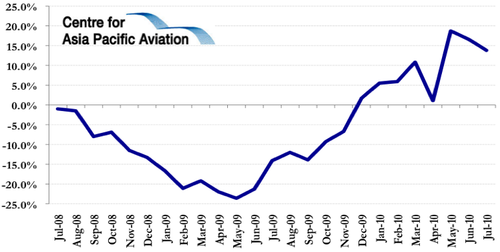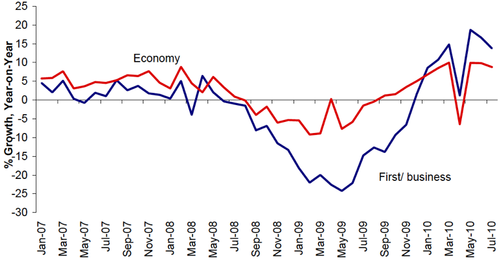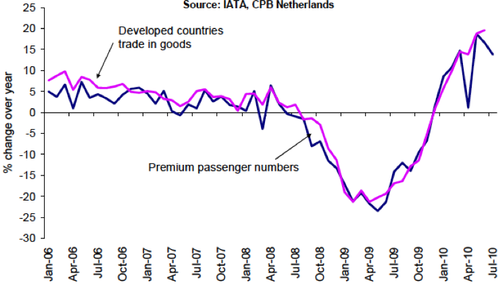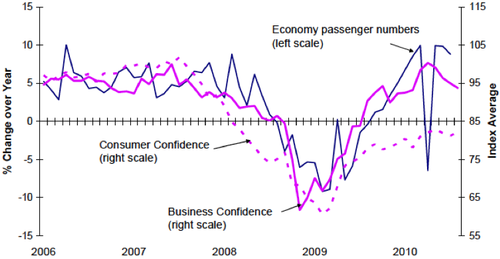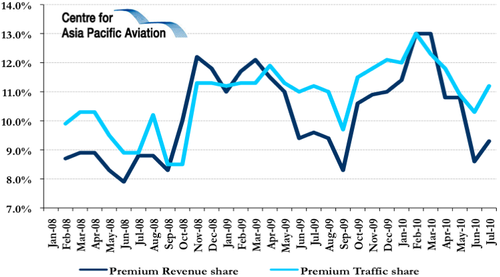Premium traffic growth continues but remains below pre-recession peak; growth expected to slow: IATA
IATA, in its Premium Traffic Monitor for Jul-2010, reported a "strong" expansion in the number of passengers on international air travel markets in Jul-2010, with the numbers travelling in premium seats being 13.8% higher on a year-on-year basis and economy traffic increasing 8.8%.
Despite this upward trend, which correlates to improved economic conditions, the number of passengers seated in premium class is still some 8% below its pre-recession peak, although economy travel has rebounded to be around 3% above its pre-recession level. Meanwhile, growth trends are expected to moderate moving forward, as monthly comparisons now compare to rising number of passengers seen during the second half of 2009.
IATA total premium traffic growth: Jul-2008 to Jul-2010
Growth rates weaker than 2Q levels but month-on-month growth accelerates
The growth rates in Jul-2010, while strong, are slightly weaker compared with growth rates observed during 1H2010, with the year-on-year comparison now against the rising number of passengers seen during the second half of 2009.
However, adjusting for seasonality and the temporary impact of the closure of European airspace, it appears that month-on-month growth in premium traffic was in fact accelerating (0.9%) in Jul-2010 compared with 2Q2010 levels (0.3%). This is an annualised pace of expansion of more than 10%. Similarly, the number of passengers travelling on economy seats grew by 1.4% in Jul-2010 compared with Jun-2010 levels, above the 0.2% average month-over-month growth rate observed during 1Q2010.
Premium traffic growth by ticket type: Jan-2007 to Jul-2010
Business travel drives growth
This prompted IATA to comment: "Clearly business travel still has considerable momentum, despite the economic uncertainties in western economies, although weaker business confidence points to some slowdown in growth rates ahead."
IATA added that in the month, growth in both seat classes continued to be driven by business travel rather than leisure. Indicators such as world trade and business confidence eased in Jul-2010 but remain positive, supporting the expansion of the premium market.
Premium revenue contributing 27% of passenger traffic revenue
Meanwhile, IATA estimated that premium revenue contributed up to 27% of passenger traffic revenue in 1H2010 while passengers travelling on premium seats represented less than 8% of the total, prompting IATA to comment: "Clearly this market segment is key to profitability for most network airlines."
Year-on-year premium revenues improved during 1H2010, albeit from the low point of the revenue cycle. This improved revenue picture continues to be driven not only by improvement in the number of passengers but also by a rise in average fare. During 1H2010, average premium fares for international travel, adjusted for seasonality, have been growing by some 8%.
Premium ticket volume and revenue growth: Jul-2007 to Jul-2010
Premium recovery dependent on economic situation
While year-on-year growth in premium passengers is now slowing, the drivers of business travel - such as world trade in goods for developed economies, which has been a good coincident indicator for business travel - remains positive, although there is uneven development in the premium market
Premium passenger and world trade growth: Jan-2006 to Jul-2010
Meanwhile, consumer confidence eased in Jul-2010 and Aug-2010, affecting leisure travel demand, with IATA stating that growth in economy class continues to be driven by business travellers sitting on economy seats rather than holidaymakers.
For more information on recent Economic Indicators, see the CAPA Economy Hot Issue.
Economy Passengers, Business and Consumer Confidence: Jan-2006 to Jul-2010
Regional differences remain
IATA added that regional differences remain in the premium demand recovery, largely reflecting differing economic conditions (with conditions stronger in the "emerging" economies compared with the Western economies), with the association stating persistently weak consumer confidence in the West suggests that leisure travel will remain soft during the second half of the year.
International premium traffic growth by route: Jul-2010
Meanwhile, routes linked to Asia and Middle East continued to show strong double-digit growth rates as strong Asian economies generate trade and business travel, with the largest percentage expansions being seen in routes linked to the emerging markets of Asia, Middle East and Latin America.
IATA passenger and freight growth analysis by region: Jul-2010
|
Passenger growth |
|
|---|---|
|
Within Europe traffic grew by 17.4% in Jul-2010, with IATA stating that it believes the number of long-haul premium passengers connecting via European hubs increased. Within Europe continued to show surprisingly strong double-digit growth rates (17.1%), albeit slowing down compared to growth rates observed in June (24.2%) and May (23.0%) as the base of comparison is now higher. IATA believes this strong growth observed represents for a large part all long-haul premium passengers connecting through European hubs rather than business travel within Europe. The bulk of long-haul premium travellers connecting via Europe are travelling to the Far-East and to the Middle East. |
|
|
Within South America |
The largest expansion was for Within South America (51.6%). Although this is a relatively small market in size, routes within this region have been expanding strongly since beginning of 2010 with an average growth rate of 22% and have been accelerating since May-2010. Economic conditions in this region, boosted by strong economies such as Brazil and Argentina, are good with GDP expected to reach 5.4% in 2010. This is supporting the development of travel markets in this region. |
|
Within Far East |
Represents about 10% of traffic, rose by a strong 23.9% in Jul-2010, following a 28.5% rise in Jun-2010. The new economic co-operation agreement signed between China and Taiwan in early Sep-2010 is likely to boost trade between these two countries which would stimulate further business travel activities in this region. |
|
North Atlantic |
The North Atlantic market is still suffering from weak economic conditions in Europe. The outlook for most Western European countries is for only a small recovery with a GDP expected to grow by only 0.8% in 2010. The end of the fiscal stimulus package in most European economies and the need to reduce budget deficits, will act as headwinds to faster economic growth and may hamper business and economy travel growth. North Atlantic traffic rose 5.9% in the month. |
Meanwhile, the market within the Far East witnessed the highest growth in first/business and economy traffic growth in the month. Premium revenue and traffic shares have slumped throughout the year, with a pickup being seen in Jul-2010.
Traffic Growth by Route - Jun-2010
IATA Middle East premium revenue share vs premium traffic share Jan-08 to Jul-2010
IATA cautiously optimistic but expects some slowing in months ahead
IATA has continually commented that it remains "cautiously optimistic" moving forward, as business confidence improves. However, growth following an initial surge, is expected to slow, with the industry unlikely to be able sustain the strong momentum moving forward.
